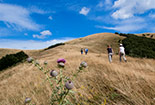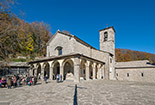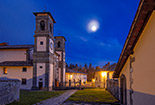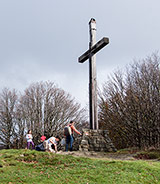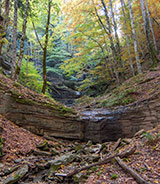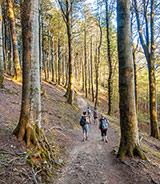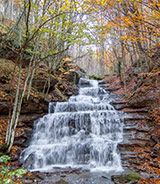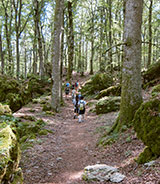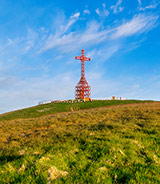Between nature and history in the National Park
in Casentino, a Tuscan valley with which you can get familiar in every detail through this site
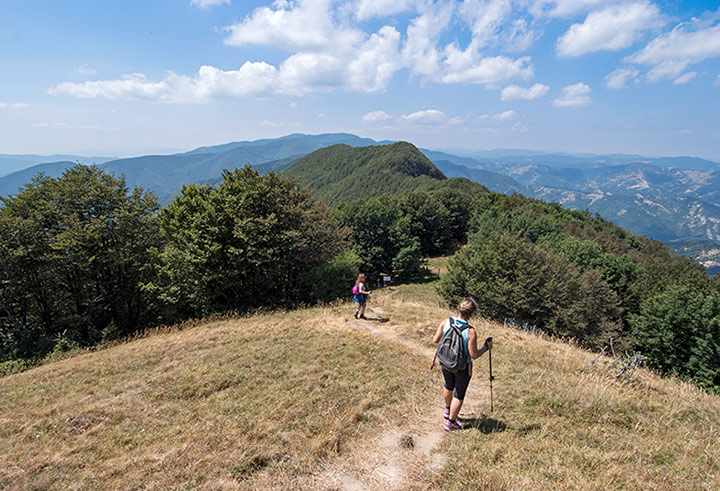
Texts and photos by Alessandro Ferrini ©
Historical naturalistic itineraries in the Casentino Forests Park
 The National Park of the Casentinesi Forests, Monte Falterona and Campigna is a vast mountainous area of almost 37,000 hectares located on the Tuscan-Romagna Apennines. An area where we can "invent" numerous itineraries to try out walks and hikes of all lengths and degrees of difficulty. The paths in the National Park take us through various types of woods, but we will walk mostly through beech and fir woods. We will meet many streams and some spectacular waterfalls. We will walk on meadows and clearings that will offer us beautiful landscape views. The Apennine ridge is usually covered by vegetation, in the points where this is missing we will have breathtaking views, both over Tuscany and Romagna. These itineraries can combine the naturalistic aspect with the historical one because within the Parco delle Foreste Casentinesi there is no shortage of places with an important history that can be Etruscan, medieval or just a few decades ago. On the Tuscan side of the Apennines there are two well-known spiritual poles in Italy and beyond: the Hermitage and the Monastery of Camaldoli and the Franciscan Sanctuary of La Verna. Therefore discounted the possibility of being able to create paths that combine the naturalistic cut with the spiritual one.Great characters of the Middle Ages walked on the mountains that today make up the National Park. The first was San Romualdo, founder of Camaldoli in the second decade of the 11th century. Then came San Francesco who in the first and second decade of the thirteenth century frequented La Verna and certainly walked on this mountain and in the surrounding areas. Finally, at the beginning of the fourteenth century, the exiled Dante Alighieri arrived. The Supreme Poet, in his movements between Casentino and Mugello and between Casentino and Romagna, necessarily walked on Mount Falterona and in the Campigna area. Trekking in the paths of the National Park of the Casentinesi Forests, Monte Falterona and Campigna means, therefore, walking in the footsteps of great figures in Italian history, religion and literature.
The National Park of the Casentinesi Forests, Monte Falterona and Campigna is a vast mountainous area of almost 37,000 hectares located on the Tuscan-Romagna Apennines. An area where we can "invent" numerous itineraries to try out walks and hikes of all lengths and degrees of difficulty. The paths in the National Park take us through various types of woods, but we will walk mostly through beech and fir woods. We will meet many streams and some spectacular waterfalls. We will walk on meadows and clearings that will offer us beautiful landscape views. The Apennine ridge is usually covered by vegetation, in the points where this is missing we will have breathtaking views, both over Tuscany and Romagna. These itineraries can combine the naturalistic aspect with the historical one because within the Parco delle Foreste Casentinesi there is no shortage of places with an important history that can be Etruscan, medieval or just a few decades ago. On the Tuscan side of the Apennines there are two well-known spiritual poles in Italy and beyond: the Hermitage and the Monastery of Camaldoli and the Franciscan Sanctuary of La Verna. Therefore discounted the possibility of being able to create paths that combine the naturalistic cut with the spiritual one.Great characters of the Middle Ages walked on the mountains that today make up the National Park. The first was San Romualdo, founder of Camaldoli in the second decade of the 11th century. Then came San Francesco who in the first and second decade of the thirteenth century frequented La Verna and certainly walked on this mountain and in the surrounding areas. Finally, at the beginning of the fourteenth century, the exiled Dante Alighieri arrived. The Supreme Poet, in his movements between Casentino and Mugello and between Casentino and Romagna, necessarily walked on Mount Falterona and in the Campigna area. Trekking in the paths of the National Park of the Casentinesi Forests, Monte Falterona and Campigna means, therefore, walking in the footsteps of great figures in Italian history, religion and literature.
The Casentino valley is squeezed between that stretch of the Apennine ridge where the National Park is located and the large Pratomagno massif. This last mountain, as the name suggests, is characterized by a large meadow along the entire ridge, offers many possibilities for trekking and walking, of great interest from a natural, landscape and historical point of view. In the 11th century, San Giovanni Gualberto, Founder of Vallombrosa, and Guido Monado, inventor of musical writing, walked in Pratomagno.Below are the areas where you will find itineraries described in detail.
ITINERARIES FOR EXCURSIONS ON MONTE FALTERONA
ITINERARIES FOR TREKKING IN CAMPIGNA FOREST
ITINERARIES FOR WALKS AND TREKKING IN CAMALDOLI
ITINERARIES FOR WALKS AND TREKKING IN BADIA PRATAGIA
THE SPECTACULAR ROUTE OF THE VIA ROMEA
IN ITS CROSSING THE APENNINES
ITINERARIES FOR EXCURSIONS AND WALKS IN LA VERNA
ITINERARIES FOR EXCURSIONS AND TREKKING IN PRATOMAGNO
TREKKING AND WALKING ITINERARIES IN THE MOUNTAINS NEAR AREZZO
ITINERARIES FOR HIKES AND TREKKING IN ALPE DI CATENAIA















ROUTES FOR TREKKING IN THE PRATOMAGNO MASSIF



